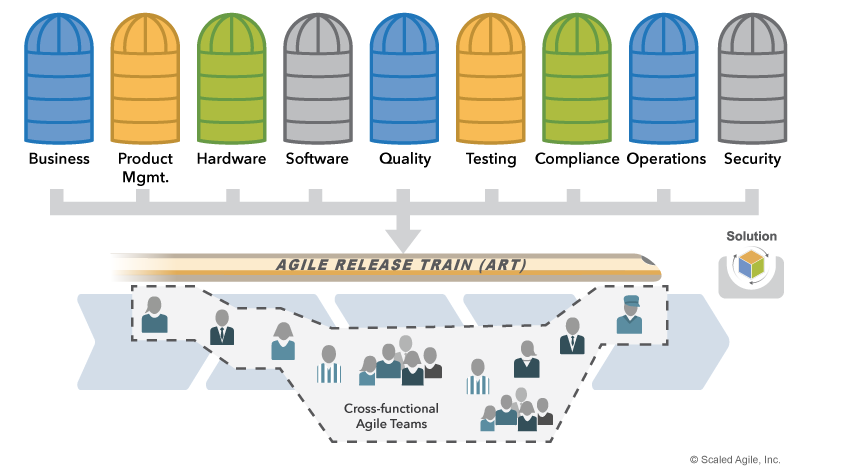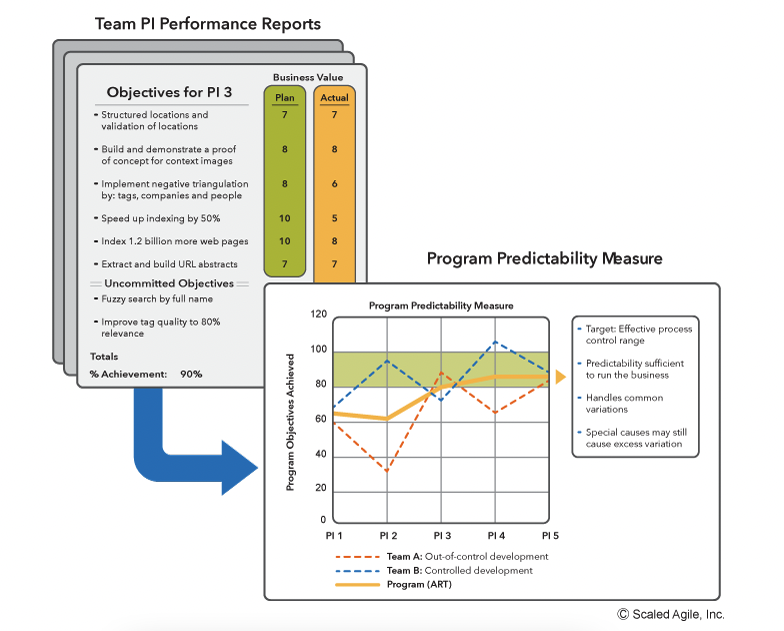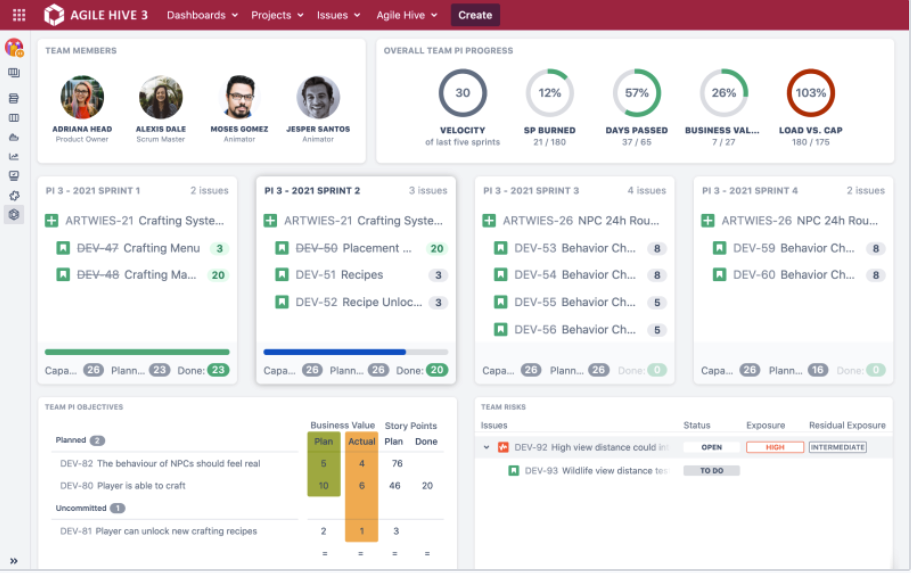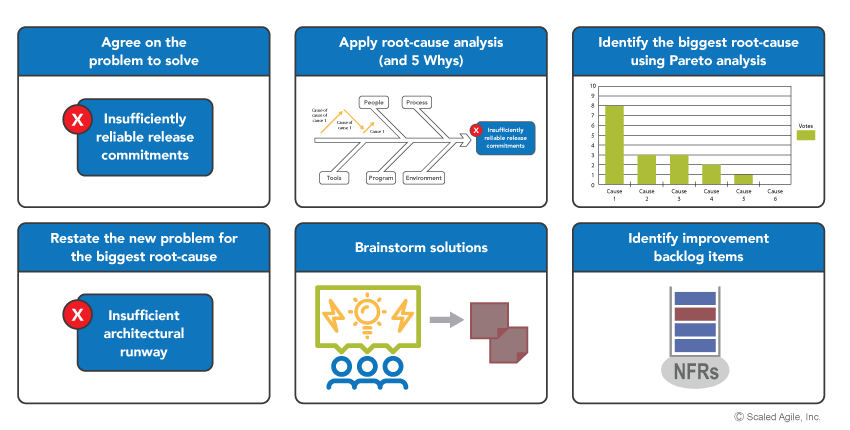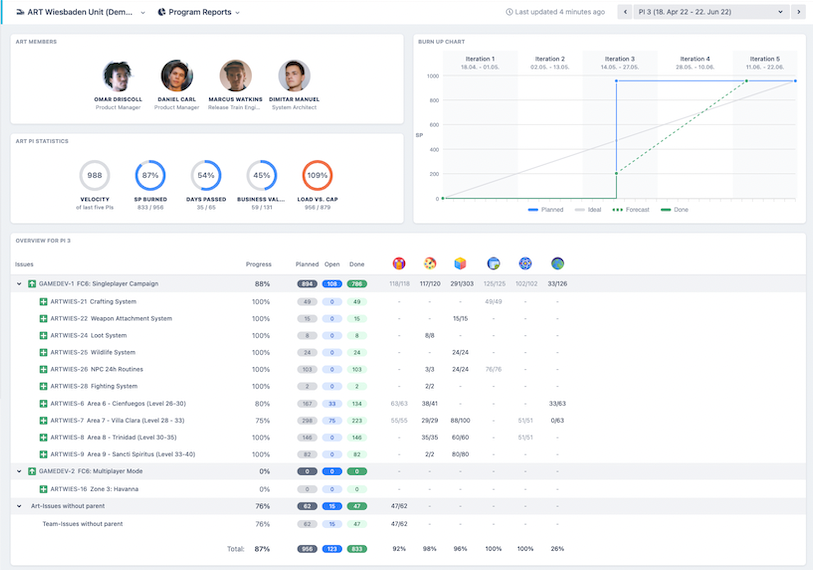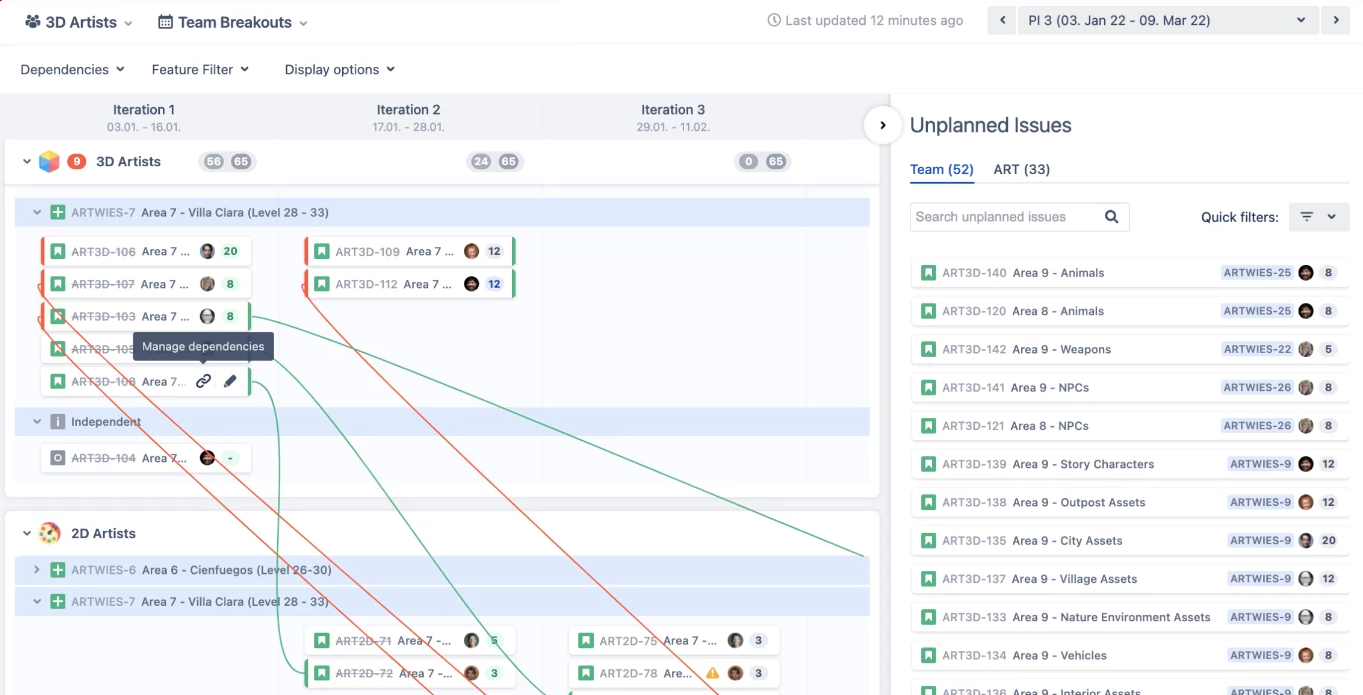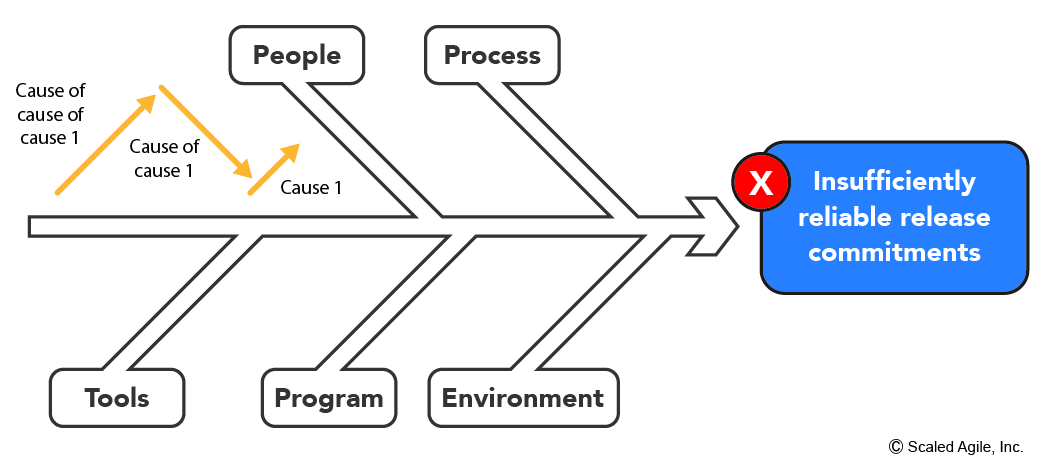“Continuous Improvement”
The concept appears, at least at first glance, to be a simple one. An uninterrupted series of development, refinement, and advancement. This is the premise behind Inspect and Adapt (I&A).
Held at the end of each program increment (PI), I&A is a critical component of Scaled Agile Framework® or SAFe®. It’s the event where the development team demonstrates and evaluates the current state of the product in development, as well as the processes used to get it there. It is after this evaluation that the teams review and reflect on items in the backlog and identify things to be improved. The PI, typically 8 to 12 weeks long, during which an Agile Release Train (ART) delivers incremental value in the form of working, tested software and systems.
This goes to the core of the Agile manifesto principle of continuous improvement and adjustment and is one of the four pillars of SAFe®; respect for people and culture, flow, innovation, and relentless improvement. Indeed, the twelfth and final principle of the Agile Manifesto, “at regular intervals, the team reflects on how to become more effective, then tunes and adjusts its behavior accordingly”, beautifully sums up how crucial the philosophy of continuous improvement is to the SAFe® Lean-Agile approach.
Every Agile Release Train (ART) Improves Every PI
The first iteration of SAFe®, released in 2011, worked to develop a methodology that differed from the project management practices of the day. Developing and maintaining a “team-centric environment” is at its core. Communication and a high level of transparency throughout the organization encourage collaborative efforts which drive productivity, drives down time-to-market, and help ensure a quality solution.
SAFe® uses well-documented, specific, and repeatable processes. Agile and lean practices ensure all teams are focused on a common set of goals. Every individual understands what the deliverables are to be and as a result, the client has a clear set of expectations to be returned. It allows each organization its own unique implementation and configuration of the combined benefits of Agile, Lean, and DevOps frameworks.
An organization-wide development process known as the Agile Release Train, or ART, sets and keeps the wheels in motion throughout the process; define, build, validate, release - repeated as needed.
It is into this context, the I&A consists of three phases; PI system demo, quantitative and qualitative measurement, and retrospective and problem-solving workshop.
PI system demo - Shows all the features developed within the ART throughout the course of the PI. Product managers here act as the facilitators and each respectively demos their portion of the features. System demos occur after every iteration. As they are also part of the I&A, Agile Hive has implemented functionality to this end, giving teams insights to ensure all respective objectives have been met.
Quantitative and qualitative measurement - Teams review metrics that measure the ART’s performance. The Release Train Engineer and Solution Train Engineer are charged with gathering and analyzing the metrics which the teams have previously agreed to and the present that data. The raw numbers (quantitative) must go hand-in-hand with a narrative (qualitative) to reveal the full story as it helps set the stage for more effective problem-solving in the following phase.
In the images above from Scaled Agile, Inc., demonstrating the relationship between Team PI Performance Reports and the Program Predictability Measure, we can see the combined total for planned objectives (“Plan”) at 50, 45 have been achieved (“Actual”) yielding a 90% rate of achievement for that PI.
Taking a look now at the image above, specifically in the bottom lefthand corner, we can see the Team PI Performance table is included right within Agile Hive. Additionally, as part of an upcoming release, we will see the implementation of the Program Predictability Measure graph in Agile Hive as well. These features are additional examples of how Agile Hive enables the implementation of SAFe® “by the book”.
Retrospective and problem-solving workshop - In this final phase, teams identify all problems or process issues, then refine them to a handful of key issues at either the team or program level. In order to separate cause from symptoms, the problem-solving workshop begins with root-cause analysis.
Importance of the Retrospective to Inspect & Adapt
Held at the end of each Agile sprint, the Retrospective is a meeting that offers the opportunity for the team to take a closer look at their working environment, engage in a variety of team-building exercises, and overall reflect on how to make their efforts more impactful. In a retrospective, the team with the help of a facilitator has total control of both the meeting agenda as well as the overall outcome. Only the team’s working output and results, never individuals, are the focus of criticism.
In these brief (30 minutes or less) sessions, a handful of significant issues are identified which will then be addressed in the problem-solving workshop that follows. Each team as a whole can either work on a problem together, or what typically occurs is the formation of new groups comprised of individuals spanning different teams who all want to work on the same issue collectively. The latter situation offers greater cross-functionality and brings different views of the same problem. These are the individuals most specifically impacted and thus, best motivated to discuss and address the issue.
As introduced above in the three phases of I&A, the problem-solving workshop is used to address systematic problems using a root-cause methodology held by the ART. This type of analysis offers a set of tools to best identify the actual causes of a problem versus simply addressing related symptoms. The diagram below helps illustrate the structure of the workshop, typically facilitated by the Release Train Engineer, in a two-hour or less timeframe.
Examples of these problem-solving tools include the Ishikawa Diagram (also known as the “fishbone diagram”) and the “5 Whys Technique”. Brainstorming by the team helps identify the likely causes contributing to the issue. As each cause is identified, the “5 Whys Technique” is employed, as one might guess by asking why multiple times, to flush out the previous causes. This continues until the root cause has been identified. Again, we see “continuous improvement” in practice.
Drawing the process to a conclusion, once the problem has been refined and restated, the team brainstorms (within a timebox of 15-30 minutes) as many corrective actions as possible. The team votes on up to three of the most likely possible solutions, and these are then developed into stories and features that will be integral to the PI Planning event that will then follow along in the process.
Most certainly along the way, you and your team want to have a clear understanding of the status of the project; an overview of the progress, scope changes (if any) as well as the forecast. This is easily achieved using Burnup Charts, recently added to Agile Hive. Burnup Charts identify and assist in the process of solving issues, help estimate the project’s completion date, and overall improves the level of communication for all members involved in one chart:
The Integration of ART, Agile Hive, and Confluence
Now that we’ve discussed the nuances of I&A and how it is a critical component of SAFe® being held at the end of each PI, let’s now turn more specifically to Agile Hive’s unique features and functionality being the easiest way to implement SAFe® in Jira and ensure your PI Planning runs smoothly With a solid PI Planning in place, there’s nothing in the way for a successful Inspect and Adapt.
Program Increment (PI) planning must be in place to truly implement and practice SAFe®. Traditionally, these face-to-face events serve as the basis for the Agile Release Train (ART), aligning teams on the vision and goals and the steps to get there. Agile Hive provides the platform for either traditional or remote PI’s.
Agile Hive’s automated Program Board provides the ability to view progress, including the status of features, ART objectives, and risks. Agile Hive offers the tools to create, manage & visualize PIs, iterations, work items, capacities, and (external) dependencies. At a glance, you can quickly gain an understanding of the dependencies between issues to support planning.
Traditionally, the work of a PI and the ART needed to occur in person. Agile Hive has proven that critical work can continue remotely when needed or preferred, and as the previous two years have demonstrated, is very much a requirement moving forward.
When using Agile Hive, the integrated Autopage plugin automatically creates pages with predefined templates that can be used for working with SAFe®. AutoPage creates, links, and updates Confluence pages, page trees, and the page content automatically through Jira. This functionality is mostly used to automize the creation of the 'Epic Hypothesis Statement', the Weighted Shortest Job First (WSJF) documentation, and the 'Lean Business Case'.
For example, when a sprint is closed, a Confluence page can automatically be created and customized. For example a retropage for teams such as the Ishikawa Diagram, also known as the “fishbone diagram”. This visual tool is used to identify sources of variation in a process. At the “head of the fish” is written a summary of the problem statement identified. An additional part of this process is instigating the 5 Whys technique.
The 5 Whys as applied to the fishbone diagram include the following categories, that make up the body of the fish; people, process, tools, program, and environment. Team members brainstorm as to the causes they believe contributed to the problem to be solved, and using the categories above, group them as they see applicable. By asking “why” multiple times, the trigger of the previous cause is identified and added to the fishbone. This continues until a root cause has been identified and then the process is repeated in regards to the next cause.
Whether it’s Essential, Large Solution, Portfolio, or Full SAFe, Agile Hive is capable and ready. Hierarchies, artifacts, processes, and reports that are all SAFe compliant are integrated right into your Jira. Additionally, Agile Hive gives you a report for each team as well as each SAFe® configuration layer.
- Essential – Agile Teams: Agile teams plan and track their work with intuitive breakout boards and real-time SAFe reports to create as much business value as possible.
- Program: Product Managers manage the idea intake, prioritize the backlog, and track progress with real-time SAFe reports. RTEs are able to ensure that ARTs run smoothly.
- Large Solution: Solution Managers manage the idea intake, prioritize the backlog, and track progress with real-time comprehensive SAFe reports.
- Portfolio: Portfolio Managers prioritize the backlog, manage Epic Hypothesis Statements, Lean Business Cases, and track progress with real-time SAFe reports.
Team Context and Team Breakouts are also made available. The Team Breakout view has been designed to coordinate the back and forth conversations between team members. The Breakout Board is feature-rich and helps to simplify breakout sessions in PI Planning.
Each team plans its iterations and breaks down features into individual stories. To tie it all together, Agile Hive’s automated Program Board combines details from each so dependencies can be easily seen and addressed. For instance, you can set the Sprint Capacity within the Breakout Board. If changes need to be made in your team’s capacity for whatever reason, adjustments can be made with a few simple clicks.
In short, with Agile Hive, you’ll have the tools needed to create, manage & visualize PIs, iterations, work items, capacities, and (external) dependencies.
Next Steps
After our dive into Inspect and Adapt (I&A) and its role within SAFe®, along with an overview of Agile Hive and its tight integration with SAFe®, perhaps you are interested in learning more? If so, please feel free to reach out and contact us at Seibert Media. We’ll be happy to get you started!
Further Reading
- Simulated Agility: When Agile Transformations Go Wrong
- 4 Useful Ways to Escape the Time-wasting Loop with SAFe® and Agile Hive
- SAFe® – Can You Scale Agile Without Chaos?
- Confluence & Agile Hive – The Dynamic Duo
- Happy PIPping – Vodafone’s Road to Business Agility with SAFe® and Agile Hive
- Case Study: How Agile Hive Helps DIY Chain toom Scale Agile

